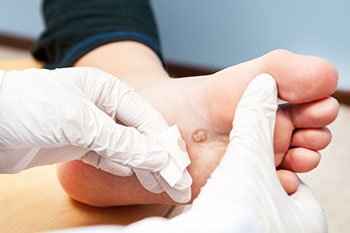
A podiatrist is a medical professional that specializes in the diagnosis and treatment of foot conditions. In some states, podiatrists can also treat ankle and lower limb issues. Podiatrists must obtain a 4-year bachelor’s degree, attend four years of podiatric medical school, and undergo residency training for three or more years in hospitals or clinics. After completing training, they must pass a series of board certification exams. Once fully licensed in their state, they can show the letters DPM after their names, which stands for Doctor of Podiatric Medicine. If they choose to specialize, they must complete a fellowship and pass certification exams in the area(s) of specialization. This can include a variety of sub-specialties, including but not limited to orthotics, diabetes, and pediatric foot care. Though podiatrists are not technically physicians, they undergo as much training as medical doctors. Podiatrists differ from orthopedists in that they treat lower limb disorders and not musculoskeletal disorders of the body. If you are suffering from pain, numbness, or swelling in your feet or have any questions related to the feet, it is suggested that you make an appointment with a podiatrist who can talk to you at length.
If you are dealing with pain in your feet and ankles, you may want to seek help from a podiatrist. Feel free to contact one of our podiatrists from Foot & Ankle Centers of Charlotte County . Our doctors can provide the care you need to keep you pain-free and on your feet.
What Is a Podiatrist?
A podiatrist is a doctor of podiatric medicine who diagnoses and treats conditions of the foot, ankle, and related structures of the leg. Your podiatrist may specialize in a certain field such as sports medicine, wound care, pediatrics, and diabetic care. Podiatrists have the ability to become board certified through training, clinical experience, and then taking an exam.
What Do Podiatrists Do?
On a daily basis, a podiatrist may perform the following activities:
- Diagnose foot ailments such as ulcers, tumors, fractures, etc.
- Use innovative methods to treat conditions
- Use corrective orthotics, casts, and strappings to correct deformities
- Correct walking patterns and balance
- Provide individual consultations to patients
It is very important that you take care of your feet. It’s easy to take having healthy feet for granted, however foot problems tend to be among the most common health conditions. Podiatrists can help diagnose and treat a variety of feet related conditions, so it is crucial that you visit one if you need assistance.
If you have any questions please feel free to contact our offices located in Punta Gorda and Port Charlotte, FL . We offer the newest diagnostic and treatment technologies for all your foot and ankle needs.




